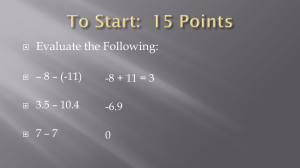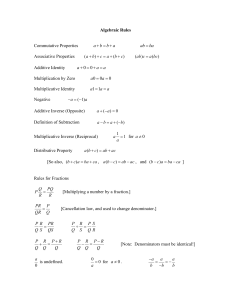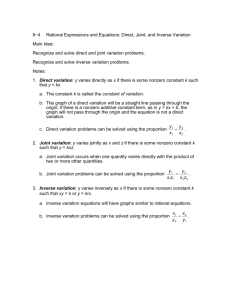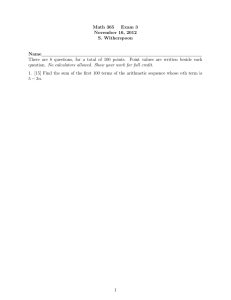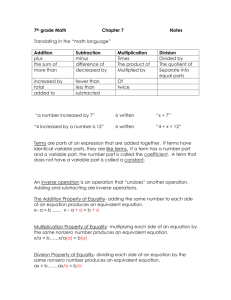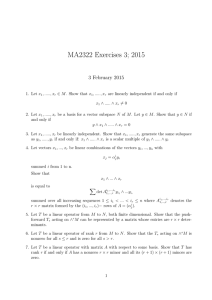Document 10450134
advertisement
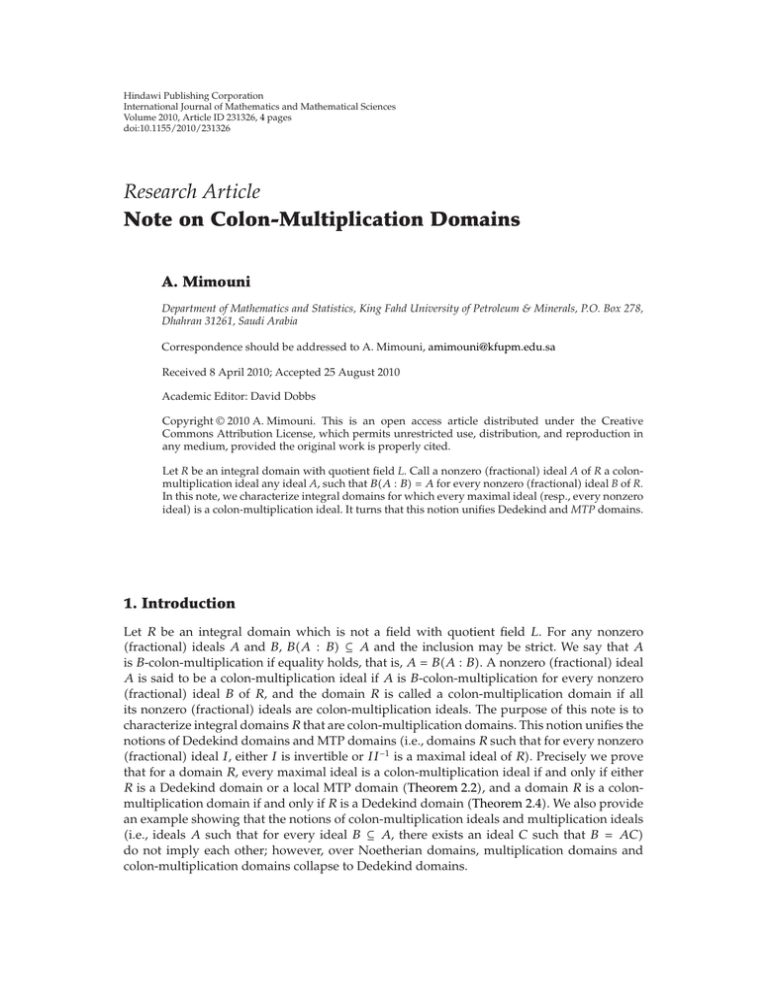
Hindawi Publishing Corporation
International Journal of Mathematics and Mathematical Sciences
Volume 2010, Article ID 231326, 4 pages
doi:10.1155/2010/231326
Research Article
Note on Colon-Multiplication Domains
A. Mimouni
Department of Mathematics and Statistics, King Fahd University of Petroleum & Minerals, P.O. Box 278,
Dhahran 31261, Saudi Arabia
Correspondence should be addressed to A. Mimouni, amimouni@kfupm.edu.sa
Received 8 April 2010; Accepted 25 August 2010
Academic Editor: David Dobbs
Copyright q 2010 A. Mimouni. This is an open access article distributed under the Creative
Commons Attribution License, which permits unrestricted use, distribution, and reproduction in
any medium, provided the original work is properly cited.
Let R be an integral domain with quotient field L. Call a nonzero fractional ideal A of R a colonmultiplication ideal any ideal A, such that BA : B A for every nonzero fractional ideal B of R.
In this note, we characterize integral domains for which every maximal ideal resp., every nonzero
ideal is a colon-multiplication ideal. It turns that this notion unifies Dedekind and MTP domains.
1. Introduction
Let R be an integral domain which is not a field with quotient field L. For any nonzero
fractional ideals A and B, BA : B ⊆ A and the inclusion may be strict. We say that A
is B-colon-multiplication if equality holds, that is, A BA : B. A nonzero fractional ideal
A is said to be a colon-multiplication ideal if A is B-colon-multiplication for every nonzero
fractional ideal B of R, and the domain R is called a colon-multiplication domain if all
its nonzero fractional ideals are colon-multiplication ideals. The purpose of this note is to
characterize integral domains R that are colon-multiplication domains. This notion unifies the
notions of Dedekind domains and MTP domains i.e., domains R such that for every nonzero
fractional ideal I, either I is invertible or II −1 is a maximal ideal of R. Precisely we prove
that for a domain R, every maximal ideal is a colon-multiplication ideal if and only if either
R is a Dedekind domain or a local MTP domain Theorem 2.2, and a domain R is a colonmultiplication domain if and only if R is a Dedekind domain Theorem 2.4. We also provide
an example showing that the notions of colon-multiplication ideals and multiplication ideals
i.e., ideals A such that for every ideal B ⊆ A, there exists an ideal C such that B AC
do not imply each other; however, over Noetherian domains, multiplication domains and
colon-multiplication domains collapse to Dedekind domains.
2
International Journal of Mathematics and Mathematical Sciences
Throughout, R is an integral domain with quotient field L, SpecR denotes the set of
all prime ideals of R, and FR denotes the set of all nonzero fractional ideals of R, that is,
R-submodules of L such that dA ⊆ R for some nonzero d ∈ R. For A, B ∈ FR, A : B {x ∈
L | xB ⊆ A} and A−1 R : A. Unreferenced material is standard, typically as in 1 or 2.
2. Main Results
Definition 2.1. 1 Let R be a domain, and A and B two nonzero fractional ideals of R. We
say that A is B-colon-multiplication if A BA : B.
2 A nonzero fractional ideal A is said to be a colon-multiplication ideal if A is Bcolon-multiplication for every nonzero fractional ideal B of R.
3 A domain R is said to be a colon-multiplication domain if every nonzero
fractional ideal A of R is colon-multiplication.
Our first main theorem characterizes integral domains for which every maximal ideal
is colon-multiplication. Before stating the result, we recall that a domain R is said to be an
MTP domain MTP stands for maximal trace property if for every nonzero fractional ideal
I of R either II −1 R or II −1 M is a maximal ideal of R 3. For more details on the trace
properties see 4.
Theorem 2.2. Let R be an integral domain. The following statements are equivalent.
1 Every nonzero prime ideal of R is colon-multiplication;
2 Every maximal ideal of R is colon-multiplication;
3 Either R is a Dedekind domain or a local MTP domain.
We need the following lemma.
Lemma 2.3. Let R be an integral domain and I a nonzero invertible (fractional) ideal of R. Then every
nonzero (fractional) ideal A of R is I-colon-multiplication.
Proof. This follows immediately from the easily verified fact that if I is invertible, then A :
I AI −1 for each nonzero ideal A.
Proof of Theorem 2.2. 1 ⇒ 2 Trivial.
2 ⇒ 3 First we claim that R is an MTP domain. Indeed, let I be a nonzero
fractional ideal of R. Assume that II −1 R and let M be a maximal ideal such that
II −1 ⊆ M. Then I −1 ⊆ M : I ⊆ I −1 and so I −1 M : I. Since M is I-colon-multiplication,
M IM : I II −1 , and therefore R is an MTP domain. Now, if R is a Dedekind domain,
we are done. Assume that R is not Dedekind. Then R is an MTP domain with a unique
noninvertible maximal ideal M 4, Corollary 2.11. Then MM−1 M. Now if N is a maximal
ideal of R, by 2 N is M-colon-multiplication. So N MN : M ⊆ MM−1 M and, by
maximality, N M. It follows that R is a local MTP domain, as desired.
3 ⇒ 1 If R is a Dedekind domain, then 1 it holds by Lemma 2.3. Assume that
R is a local MTP domain. Then R is a one-dimensional domain 3, Proposition 2.10. Hence
SpecR {0 M} and so M is the unique nonzero prime ideal of R. Now, let A be a
nonzero fractional ideal of R. If A is invertible, by Lemma 2.3, M is A-colon-multiplication.
Assume that AA−1 R. Then necessarily AA−1 M. Hence A−1 M : A and therefore
M AA−1 AM : A, as desired.
International Journal of Mathematics and Mathematical Sciences
3
The next result shows that colon-multiplication domains collapse to Dedekind
domains.
Theorem 2.4. Let R be an integral domain. The following statements are equivalent.
1 R is a colon-multiplication domain;
2 Every nonzero principal (fractional) ideal of R is colon-multiplication;
3 R has a nonzero principal (fractional) ideal that is colon-multiplication;
4 R is a Dedekind domain.
Proof. 1⇒2⇒3 are trivial.
3⇒4 Suppose that R has a nonzero principal fractional ideal I aR that is colonmultiplication. Let J be any nonzero ideal of R. Then I is J-colon-multiplication. Hence aR I JI : J JaR : J aJJ −1 and therefore R JJ −1 , as desired.
4⇒1. it Follows immediately from Lemma 2.3.
We recall that an ideal A of a commutative ring R is a multiplication ideal if for every
ideal B ⊆ A there exists an ideal C such that B AC, and the ring R is a multiplication
ring if each ideal of R is a multiplication ideal. Note that from the equation B AC, we
have C ⊆ B : A. Thus B AC ⊆ AB : A, and so we have B AB : A. Hence if
A is a multiplication ideal of an integral domain R, then every subideal B of A is A-colonmultiplication. According to 5, a multiplication ideal is locally principal, but not conversely.
However, a finitely generated locally principal ideal is a multiplication ideal 6. In particular,
in Noetherian domain, multiplication domain and colon-multiplication domain collapse to
Dedekind domain. However, the two notions multiplication and colon-multiplication do
not imply each other as is shown by the following example.
Example 2.5. 1 It provides a maximal ideal M of a domain R which is colon-multiplication
but not a multiplication ideal.
Let k be a field and X and Y indeterminates over k. Set R k Y kXY k M.
Clearly R is a one-dimensional PVD pseudovaluation domain and therefore a local MTP
domain here note that pseudovaluation domains have the trace property, 3, Example 2.12,
and so the maximal trace property if dim R 1. By Theorem 2.2, M is colon-multiplication.
However, M is not a multiplication ideal since M is not “locally” principal 5.
2 Let R be a non-Dedekind domain. By Theorem 2.4, not every nonzero principal
ideal is colon-multiplication. However, every principal ideal is a multiplication ideal 6.
Given a nonzero fractional ideal A of an integral domain, we define the map ϕA :
FR → FR, B → AB : A. The next proposition characterizes maps ϕA that are surjective.
Proposition 2.6. Let R be an integral domain and A a nonzero (fractional) ideal of R. The following
conditions are equivalent.
1 ϕA id (i.e., B is A-colon-multiplication for each B ∈ FR);
2 ϕA is surjective;
3 A is invertible.
Proof. 1⇒2 Trivial.
4
International Journal of Mathematics and Mathematical Sciences
2⇒3 Assume that ϕA is surjective. Then there exists B ∈ FR such that AB : A ϕA B R. Hence A is invertible.
3⇒1 Assume that A is invertible. By Lemma 2.3, every B ∈ FR is A-colonmultiplication. Hence ϕA B AB : A B and so ϕA id.
Acknowledgment
This work was supported by KFUPM.
References
1 R. Gilmer, Multiplicative Ideal Theory, vol. 12 of Pure and Applied Mathematics, Marcel Dekker, New York,
NY, USA, 1972.
2 I. Kaplansky, Commutative Rings, University of Chicago Press, Chicago, Ill, USA, Revised edition, 1974.
3 W. J. Heinzer and I. J. Papick, “The radical trace property,” Journal of Algebra, vol. 112, no. 1, pp. 110–121,
1988.
4 M. Fontana, J. A. Huckaba, and I. J. Papick, “Domains satisfying the trace property,” Journal of Algebra,
vol. 107, no. 1, pp. 169–182, 1987.
5 D. D. Anderson, “Multiplication ideals, multiplication rings, and the ring RX,” Canadian Journal of
Mathematics, vol. 28, no. 4, pp. 760–768, 1976.
6 J. W. Brewer and E. A. Rutter, “A note on finitely generated ideals which are locally principal,”
Proceedings of the American Mathematical Society, vol. 31, pp. 429–432, 1972.


